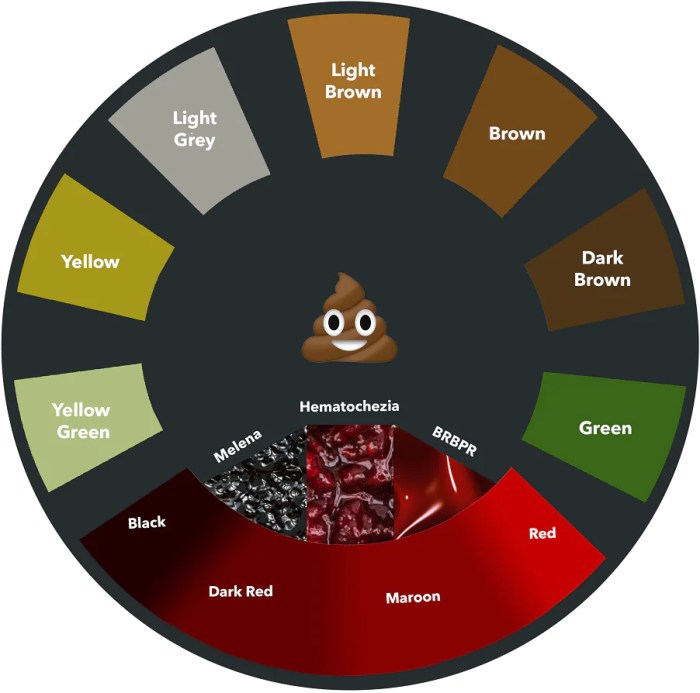Causes of Red or Dark Stool

Blood or food coloring in stool – Changes in stool color, specifically the appearance of red or dark hues, can be alarming. Understanding the potential causes, however, can help alleviate anxiety and guide appropriate medical attention. The color of your stool provides valuable clues about the location and severity of potential gastrointestinal issues.
Upper and Lower Gastrointestinal Bleeding, Blood or food coloring in stool
The location of bleeding within the gastrointestinal tract significantly impacts the appearance of the stool. Upper gastrointestinal bleeding, originating from the esophagus, stomach, or duodenum, typically results in dark, tarry stools (melena). This is due to the digestion and oxidation of blood as it travels through the digestive system. In contrast, lower gastrointestinal bleeding, originating from the small intestine, colon, or rectum, often presents as bright red blood in the stool or on the surface.
The color difference is a key diagnostic indicator for healthcare professionals. The speed at which blood passes through the digestive system determines the extent of color alteration.
Stool Appearance and Bleeding Location
Bright red blood in the stool strongly suggests lower gastrointestinal bleeding, often originating from the rectum or anus. This may be due to hemorrhoids, anal fissures, or colorectal polyps. Dark, tarry stools (melena), often described as having a sticky, black, and shiny appearance, indicate upper gastrointestinal bleeding. However, dark stool isn’t always indicative of bleeding; certain foods and medications can also cause this color change.
The presence of blood clots within the stool can also indicate the severity and location of bleeding, requiring immediate medical evaluation. A maroon-colored stool suggests bleeding somewhere in the lower gastrointestinal tract, potentially from the small intestine or the right side of the colon.
Foods and Medications Affecting Stool Color
Several foods and medications can temporarily alter stool color, mimicking the appearance of blood. It’s crucial to consider recent dietary intake and medication use when assessing changes in stool color.
| Food/Medication | Color Change | Mechanism | Duration |
|---|---|---|---|
| Beets | Red or reddish-pink | Beetroot contains pigments that are not fully digested and excreted | 1-2 days |
| Red Licorice | Dark red or black | Contains pigments that affect stool color | Several days, depending on consumption |
| Iron Supplements | Black or dark green | Iron is poorly absorbed and excreted in the feces | While taking medication |
| Bismuth Subsalicylate (Pepto-Bismol) | Black or dark stool | Bismuth reacts in the gut, causing a dark discoloration | While taking medication |
Differentiating Bleeding from Harmless Color Changes
Differentiating between harmless color changes and actual bleeding requires careful consideration of accompanying symptoms. While changes in stool color alone can be concerning, the presence of additional symptoms such as abdominal pain, cramping, weakness, dizziness, or persistent vomiting suggests a more serious underlying condition requiring immediate medical attention. The absence of these symptoms alongside a recent dietary change or medication use strongly suggests a benign cause for the altered stool color.
The presence of unusual colors in stool, such as red or black, often raises concerns about blood. However, dietary factors can also contribute to discoloration. Consumption of foods containing vibrant dyes, for instance, can result in altered stool color; the use of a purple food coloring gel in baked goods or desserts could easily lead to a purple hue.
Therefore, differentiating between blood and food coloring requires careful consideration of recent dietary intake.
If there is any uncertainty, seeking professional medical advice is crucial.
Illustrative Examples: Blood Or Food Coloring In Stool

Misinterpreting the color of stool can lead to unnecessary anxiety or, conversely, delay crucial medical intervention. The following case studies illustrate the importance of accurate assessment and the potential pitfalls of relying solely on visual observation.
Food Coloring Mistaken for Blood
A 45-year-old woman presented to her physician reporting bright red blood in her stool. She had consumed a significant amount of red-colored food and beverages, including red gelatin dessert and cherry juice, the day before. The woman experienced no other gastrointestinal symptoms such as abdominal pain, cramping, or changes in bowel habits. A thorough physical examination revealed no abnormalities.
Further investigation, including a stool test for occult blood, yielded negative results. The physician explained the likely cause of the red discoloration was the food coloring, and reassured the patient. No further medical intervention was required. This case highlights how dietary intake can significantly influence stool color, potentially leading to misdiagnosis if not considered carefully.
Blood in Stool Mistaken for Food Coloring
A 60-year-old man experienced dark, tarry stools for several days. He attributed the color change to consuming dark-colored foods, dismissing the symptom. He delayed seeking medical attention for over a week. When he finally consulted a physician, further investigation revealed significant gastrointestinal bleeding, requiring immediate hospitalization and intervention. The delay in diagnosis resulted from the incorrect assumption that the dark stool was solely due to food.
This case emphasizes the critical need for prompt medical evaluation when changes in stool color or consistency occur, especially when accompanied by other symptoms like fatigue or abdominal pain. The consequences of delayed diagnosis in this case were potentially life-threatening.
Impact of Lighting Conditions on Stool Color Perception
The perceived color of stool can be significantly influenced by lighting conditions. For example, stool that appears dark brown under incandescent lighting might appear black under fluorescent lighting, potentially leading to misinterpretation. Similarly, reddish hues might be less pronounced in dim lighting. This variability underscores the importance of consistent and well-lit conditions when assessing stool color. Accurate assessment requires good lighting and careful observation, rather than relying on a quick glance under variable lighting conditions.
A standardized assessment environment, if possible, is crucial for reliable interpretation.
FAQ Summary
How long does food coloring typically stay in the stool?
It usually takes 1-2 days for food coloring to completely clear from the system.
Can stress affect stool color?
While not directly changing color, stress can impact digestion and potentially lead to changes in stool consistency and frequency, sometimes indirectly affecting its appearance.
What if I see only a small amount of blood in my stool?
Even a small amount of blood warrants a visit to your doctor to rule out any underlying issues. Don’t delay seeking medical advice.
Is it possible for blood and food coloring to be present simultaneously?
Yes, it’s possible, making differentiation challenging. Detailed observation and medical consultation are essential.



